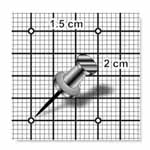Module 4: Woodlots and Wildlife
Understanding and Measuring Basal Area
Basal area (BA) is the area in square metres (or square feet) of the cross section of the trunk of a tree at breast height (1.3 m or 4.5 ft). It is most commonly used as an indicator of stand density and is expressed as square metres per hectare or square feet per acre.
BA is measured by adding the area of the stems at breast height of all the trees in the stand. Because of the time required to measure every tree, only a sample of the stand is measured. The sample is used to predict the total amount of basal area in the stand. This is the method used most by contractors and large forest industrial landholders.
The most common methods of sampling a stand to determine the basal area are to use a prism or relascope. These methods are quick and easy.
PRISM
Prisms can be purchased from most forestry supply stores. They can be used as follows:
 Go to a spot in a stand and do a complete circle, counting those trees that are completely displaced (see illustration). With a prism you need to use the prism as the centre of the plot and rotate around it. Multiply the number of in trees by 2 to get the basal area for the stand in square meters per ha. (For example, if you count 20 trees, your basal area is 40 square metres per hectare).
Go to a spot in a stand and do a complete circle, counting those trees that are completely displaced (see illustration). With a prism you need to use the prism as the centre of the plot and rotate around it. Multiply the number of in trees by 2 to get the basal area for the stand in square meters per ha. (For example, if you count 20 trees, your basal area is 40 square metres per hectare).
RELASCOPE
The main advantage of a relascope is that it can be made inexpensively with some string or chain, and a stiff piece of cardboard or plastic.
A 2-factor relascope can be made in 5 steps:
-
Use a pin to prick corners on a stiff piece of cardboard or plastic as marked to the left. The opening must be exactly 1.5 cm wide as drawn below. A 1 mm error in notch width will affect accuracy by approximately 10%.
-
Connect the dots with a ruler and pencil.
-
Cut out the opening with scissors or a knife.
-
Cut the edges as drawn (dimensions are not critical).
- Attach a string below the opening as shown. Knot the string exactly at 53 cm from the relascope. A 1 cm error in string length will result in a 10 % error in accuracy.
 With a 2-factor relascope (i.e. BAF = 2) each tree that completely fills the opening will represent 2 square meters of basal area per hectare. (The way it works is this: BAF = a2/y2 x 2500 where a = notch width and y = length of string)
With a 2-factor relascope (i.e. BAF = 2) each tree that completely fills the opening will represent 2 square meters of basal area per hectare. (The way it works is this: BAF = a2/y2 x 2500 where a = notch width and y = length of string)
To use the relascope, hold the knot of the string to your face and pull the other end tight horizontally away from you. Go to a spot in a stand and do a complete circle using your eye as the centre of the circle, counting only those trees that completely fill the opening in the relascope. Multiply this number by 2 to get the basal area for the stand in square meters per ha. (For example, if you count 20 trees, your basal area is 40 square meters per hectare)
 |
|
 |
|
